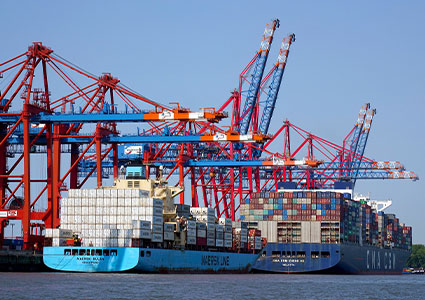
Why supply chains, upstream and downstream, must live in a data sharing world
As AI revolutionizes supply chains, both upstream (suppliers, manufacturers) and downstream (distributors, retailers, consumers) participants need to operate within a data-sharing ecosystem to boost efficiency, resilience, and responsiveness. To achieve substantial and sustained improvements in efficiency, profitability, resilience, and agility, the sharing of data is essential for optimizing supply chains.

Yet the sharing of data between the myriad different organizations within a complex modern supply chain requires trust, which is often hard to create, facing many different barriers. The absence of trust inhibits data sharing and stands in the way of a supply chain realizing its full potential.
Organizations need to work hard at establishing trust so they can use shared data to enhance decision-making at every level in the chain, fueling greater collaboration and responsiveness while reducing risk. This applies to both upstream and downstream data within a supply chain ecosystem, and it’s not enough to only focus on one direction of flow if true gains are to be made.
Upstream data and the downstream world
The upstream sharing of data from suppliers and raw material providers to vendors or manufacturers enables, amongst other things, optimization of production planning and forecasting. It brings greater understanding of lead times, quality metrics, and potential risks. Up-to-the-minute data about inventory levels, bottlenecks, price changes, or quality control information about raw materials enables manufacturers to adjust production schedules and their own distribution, sales, and marketing channels for greater efficiency. The availability of tracking data will give total transparency to shipments, so manufacturers are never caught out by early arrivals or delays.
Downstream data between the manufacturer and the distributors, sales channels, and end-users or customers is vital for manufacturers to understand demand fluctuations so they can adjust production accordingly. This makes production more closely demand-driven while optimizing inventory and distribution management – all areas which significantly impact the bottom line when not operating to maximum efficiency.
The kind of data that should be circulating in the downstream phases of a supply chain will typically include inventory levels at distribution and retailer locations, along with point-of-sale data and information from sales departments including advanced orders and customer-satisfaction metrics. Manufacturers need all this information to anticipate what customers want, to avoid costly inefficiencies such as stockouts or wrong-time, wrong-place misallocation of in-demand inventory.
Common concerns about data sharing
Despite these obvious advantages of sharing upstream and downstream data, companies throughout a supply chain have many concerns that prevent the building of trust. These range from the potential for loss of intellectual property, to the fear that competitors will get hold of data and use it to their own advantage.
Data security is also a worry for many organizations. Other businesses can see that a lack of standardization in data formats and interfaces has the potential to make sharing difficult, troublesome, time-consuming, or costly. Small and medium-sized businesses especially may feel they do not have the right in-house expertise, fearing the benefits are outweighed by the costs.
Within larger organizations, a siloed structure also makes data sharing complex, particularly if the data is owned by separate departments and in varied formats.
Barriers to supply chain trust 
These barriers to greater data sharing are far from insurmountable. However, companies that fully understand the benefits and want to implement data integration along their supply chains can win over their partners with a clear value proposition. This needs to be based on the establishment of transparent data governance frameworks and engagement of data management partners possessing the technology and experience that generates trust and confidence.
Data governance must be transparent to demonstrate who owns and is responsible for the data and security at each stage of the supply chain. Visualizations should make the flow of data clear across the supply chain and explain how partners use technology to transform the data and for what purpose. The appointment of data stewards to oversee data quality and integrity has proved a successful move in confidence-building.
Automation has a significant role to play, providing reassurance about the maintenance of data integrity and security. Current applications streamline validation and preparation in conformity with standards for accuracy and completeness, and provide the transparency required.
Advances in AI also mean auditing and monitoring of shared data is comprehensive and detailed. This provides transparency about the use of data and detects any intrusions or departures from agreed protocols quickly. Predictive capabilities spot the signs that a breach is possible and enable fast preventive action. Further security enhancements come from the encryption of data at rest and the use of privileged access controls and multi-factor authentication.
The right technology partner
Convincing supply chain partners to share their data is also a matter of confidence in the technology provider and its platform. Everyone should be persuaded to conduct due diligence to ensure their provider has the track record and the capabilities required, especially in the key area of data governance.
A platform should simplify data management and overcome the common problem of siloed data, preferably by using a more innovative approach such as the smart data fabric that unifies data for use without moving it or requiring removal and replacement of in-situ systems. This is a major advantage for all businesses, taking up less of their time in implementation and maintenance.
Leadership in collaboration is vitally important too, to establish consensus among all third parties and suppliers about data governance standards and security, and their enforcement. With third-party suppliers, achieving the right SLAs will provide guarantees around all these matters. Non-disclosure agreements are also important for confidence-building, helping convince waverers in the supply chain that the data they share will only be used for the intended purpose. Organizations should extend this approach and actively seek to build a data sharing culture based on trust, ethical standards, and the inclusion of all relevant partners.
While many concerns overlap, they can be addressed to create a compelling value proposition for the power of data sharing, which delivers significant and sustained improvements in performance, responsiveness, and profitability. Trust is not built overnight, but once established, it brings immense gains.
In a world where data sharing is the norm, supply chains become more agile, automated, and customer-centric, ultimately reducing costs and enhancing sustainability.
By Enzo Brienza
Enzo Brienza is Partnership Manager at InterSystems UKI. As a transformational business leader, Enzo has a proven track record of delivering complex information technology solutions to blue-chip customers. Enzo develops strategic partnerships with InterSystems’ clients, fostering increased revenue and driving market growth through digital transformation.
